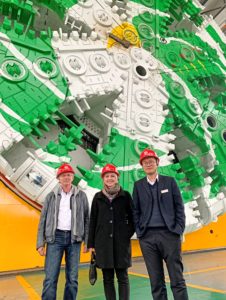The Project
Tunnel boring machines (TBMs) are extensive, highly automated, mobile “factories,” which can perform all stages of tunnel construction in one single run. The machine construction includes the cutting wheel with its drilling tools directly in front of the drilling head. Inside the drilling head, there are driving and control elements, followed by machinery for automatic material processing and removal and the equipment for the mounting of prefabricated tunnel wall elements. The biggest machines today reach a length of over 200m and a drilling diameter of up to 18m!
A particular operational challenge is the transmission of relevant sensor data from the rotating cutter wheel on the machine head to the controller located further back. One of China’s major global players in this field (CREG, China Railway Engineering Equipment Group Co., Ltd.) used Wireless PROFINET for this purpose in a current tunnel project involving a “Super-large Slurry Shield Boring Machine” with a drilling diameter of almost 15 m.
Challenges and Solution
For reliable and efficient operation of such a comprehensive production process, a powerful control system and sensor technology are required, particularly for the cutter wheel. Its mechanical stress during the drilling process and its rotational movement must be considered in the transmission of the sensor signals. Another challenge is the extremely tight space in the drill head. Furthermore, the correct sensor signal transmission is decisive for the entire machine operation: They provide the machine operator with the data for the correct tunneling.

Faced with these challenges, CREG decided to go wireless with PROFINET combined with PN-compliant DATAEAGLE 4000 radio modules (Schildknecht AG). The slave modules are mounted on the rotating cutter wheel (Figure 2, in the grey housing), while the allocated master is positioned in the stationary rotary head from there, the data is wired to the controller. The rotating and metallic environment doesn’t cause any problems for a stable radio link due to the Bluetooth radio technology with its frequency hopping being less vulnerable to reflections as well as the patented data processing procedures on the radio modules.
Conclusion
In this demanding project, radio (wireless) technology, in combination with PROFINET, has proven itself as an attractive “technology duo”; this became clear from long test runs with the TBM before its final use. This result is important beyond the actual application: “To monitor rotating machine parts with sensors attached to them and transfer the sensor data reliably via Ethernet-based communication links such as PROFINET to a controller.”
This IIoT case study is a prerequisite for countless other Industry 4.0 applications.
 Elena Eberhardt
Elena Eberhardt
Business Development Manager
Schildknecht AG
